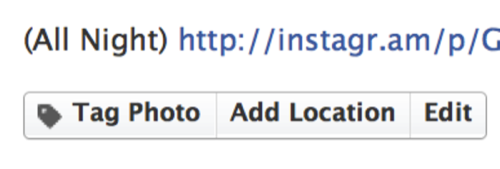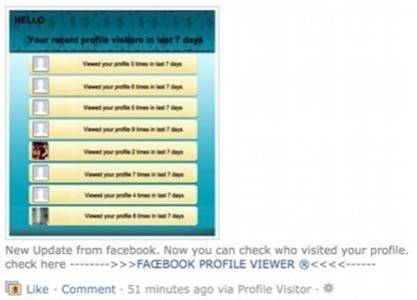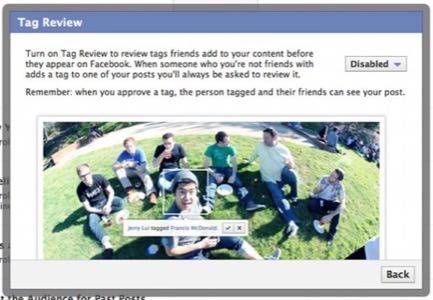That afternoon, the Facebook notifications just kept rolling in, one after the other. You’ve been tagged in a photo, the social giant eagerly announced via email, again and again. The subject of many of those photographs – we’ll call her Stacey, as she has requested anonymity – was not expecting these images to be published online, to say the least.

It’s not that the photos were anything racy or of an especially private nature. Rather, it was because these pictures had been taken by a friend a few years earlier, well before Facebook was what it is today. They weren’t taken with Instagram or Hipstamatic, or even on a digital camera at all. They had been snapped using a film-loaded, throw-away point-and-shoot camera, the kind they used to give away at weddings before everybody had their own smartphone or hand-held digital camera.
The pictures also happened to be terrible. It’s not that Stacey isn’t a photogenic person, but the flash-illuminated output from throw-away film cameras isn’t exactly the pinnacle of modern portrait photography.
As it turned out, Stacey’s friend had recently bought a 4×6 photo scanner and had spent the weekend loading in hundreds of old photos from a shoebox, uploading them to Facebook and tagging everyone in them. It was a purely innocent, friendly gesture, but one that caught many of the friends featured in the photographs off guard.
We’ve all been the recipient of such a notification. “So-and-so has tagged a photo of you.” Depending on who so-and-so is, one can’t help but instinctively wonder, “Is it a flattering photo? An interesting, well-composed one? Incriminating?”
Curating Our Own Online Identities: Why Facebook Matters
Whether we prefer to think about it this way or not, our social media profiles are a semi-public representation of who we are, or at the very least, who we want to be perceived as being.
Among all of our social presences, Facebook is uniquely important in how it portrays us in the eyes of those to whom we are connected. For one, it’s by far the biggest social network. By default, we’re connected to the widest, most eclectic mix of people there than we are anywhere else online.

On Twitter, I’m followed by people primarily because of what I write about professionally, or because my band played with their band at one point, or because we met at some nerdy media conference. Or because they are an astonishingly beautiful, bikini-clad young woman with a free iPad to give away.
On Foursquare, my connections are people I’ve met in person, most of whom also call Philadelphia home. On Pinterest, what seems like every female younger than 35 I’ve ever known is following me, eagerly awaiting the day I remember I signed up for Pinterest and actually start using it. My friends list on Path is populated by a small number of friends and colleagues, all of whom are among the earlier adopters I know (even if our own Jon Mitchell is no longer hanging out there).
Facebook is another story all together. I joined Facebook in 2004 because it was the thing to do. I was in journalism school at Temple University, and I had heard about this new MySpace-style site from a few of my friends, so I signed up. At the time, the only other people there were, very much by design, other students. That’s it.
Today, our Facebook friends list is limited only by the conscious decisions we make to accept or initiate friend requests. Sure, each of us knows a few anti-Facebook holdouts, but for the most part, everybody’s there. That includes parents, cousins, high school friends we haven’t seen in years, former colleagues and current ones. It also includes our best friends on the planet.
For many digital natives, this presents a unique, sometimes awkward challenge when it comes to publishing content to the site. This is true of status updates (which can of course be sent out to select lists, Google Circles-style), but it can be even more true of images.
Of all the data we share on Facebook – our thoughts, geographic location, recently read articles, favorite songs – photographs provide some of the strongest, most illustrative context about what our lives actually look like. That includes our physical appearance, but also our surroundings, what type of people we hang out with and what kinds of sights inspire us to tap the shutter button on Instagram.
Photographs are also somewhat unusual in this digital, social context in the sense that, by default, others are free to publish them on our behalf and identify us by name in front of all of our peers.
By now, this is simply a reality of our connected, socially networked lives. We know whenever somebody holds up a smartphone or digital camera at a party that there is some reasonable chance that the resulting image will be published on Facebook, quite possibly within a few seconds.
How to Violate the Unspoken Etiquette
In Stacey’s case, however, there was an implied statute of limitations for those images to be posted. This was due both to the passage of time and to the use of analog tools that were conceived with a decidedly different use in mind than the image-capturing gadgets we use today. The unspoken etiquette of Facebook photo tagging was broken. And it wasn’t just a handful of photos from the night before. It was dozens of old, awful-looking pictures, which suddenly dominated her Facebook profile, since they were the ones most recently posted.
The fact that Facebook displays photos in order of recency makes total sense. Why would you want a picture from 2008 to be the first thing people see when they land on your profile? In some cases, however, this feature can lead to discomfort even in routine tagging scenarios. Some Facebook users we talked to for this story expressed concerns about seeing a sudden flood of drunken party photos dominate their Timeline because a friend decided to bulk upload and tag dozens of pictures from the weekend.

For many people, something like this wouldn’t matter at all. For others, the arrival of several unruly-looking photos of them on their Facebook profile might end up placing a disproportionate amount of focus on the part of their lives that they spend letting loose.
They might get completely wasted only one night per month, but that night is dramatically more likely to be documented than most other nights. Again, this might not be a big deal to many people. But to those who take care to curate their own social persona – and who might be connected with colleagues or even bosses via Facebook – it is a concern.
Abusing the Facebook Photo Tag
The Facebook photo tag is an interesting phenomenon. By assigning one to an image, you’re explicitly adding not just new information to it, but a new social context. The person tagged is notified and is suddenly part of any conversation that takes place around that image, be it with friends, friends of friends or, in some cases, complete strangers.

Facebook obviously intends for this feature to be used to identify friends in photographs, but not everyone uses it this way.
Take Benjamin Tribbett. The Virginia-based political blogger is known to tag politicians in images that include information or commentary about legislation they’re supporting. Even though the officials are not featured in the images, Tribbett tags them as a way of drawing attention to their political activities.
“To me, this is an important tactic of “social media terrorism,” where legislators are forced to show their voting record to their friends, family and other supporters who may not know what they are really up to,” Tribbett said.
The tactic has proven popular among some of Tribbett’s peers, but obviously doesn’t sit well with the conservative politicians he targets, some of whom have called him to ask him to stop.
This unconventional use of tagging isn’t limited to the harassment of public officials. People do it everyday.
A few weeks ago, LaTonya Wilkins was tagged in a photograph on Facebook. When she went to see which picture it was, she discovered that it wasn’t one of her at all, but rather a photo of her friend posing with their newborn baby. Wilkins was tagged, along with several others, as a way to call her attention to the picture.
“I had an issue with the tag, as I do not think tagging is the proper means to notify a person of a life event,” Wilkins said. “I have also been tagged in “thank you notes” that had more information than I wanted to share with the Facebook world.”
In another instance, somebody tagged Wilkins in a photo of food they had just prepared, as a way of inviting her over for dinner.
In other cases, people have misused photo tags by tagging friends in graphics that serve as a sort of visual equivalent to email chain letters. Tags can also be used to perpetuate malware on Facebook. While it’s a more socially acceptable use of the tagging, some people we spoke to expressed discomfort with the trend toward parents being tagged in photos of their own young children.

The Solution: Self Control and Privacy Setting Adjustments
For all the anxiety some people have about photo tagging run amok, it’s a relatively easy problem to fix. After being the object of one too many unwanted tags, Wilkins changed her preferences on Facebook so that she would have to approve any tags appended by others. To take a more nuclear route, one could just make it so that tagged photos aren’t visible to anyone but themselves.
In most cases, such a pre-emptive strike isn’t even necessary; simply untagging oneself in photos as they’re posted will do. This may be challenging if one is on the go, because Facebook’s native mobile apps don’t support untagging. For that, third party apps like Photobox! for iOS can be used to manage tags from one’s iPhone.
In a perfect world, every Facebook user would adhere to the unspoken etiquette of tagging and avoid tagging excessively or publishing even debatably unflattering photos. With 800 million users, this isn’t likely to happen.
Facebook wants users to tag each other, as this helps increase engagement on the site and further build out the complex Web of social data that the company needs to make money moving forward. The site even uses facial recognition to suggest people to tag once a given photo is uploaded. The company recently revised its tagging policy in a way that seems to discourage ruthless over-tagging, but the language is a bit vague and may contradict existing policies.
With the feature woven so thoroughly into the fabric of the site, it will largely fall on users to police themselves and each other. For those experiencing unwelcome photo tags, it seems that self-untagging should be enough and, if necessary, the privacy controls are there. For everybody else, perhaps it’s worth giving some careful thought to that next bulk photo upload.
Lead photo by Joel Telling. Beer bong photo by TheChanel.










